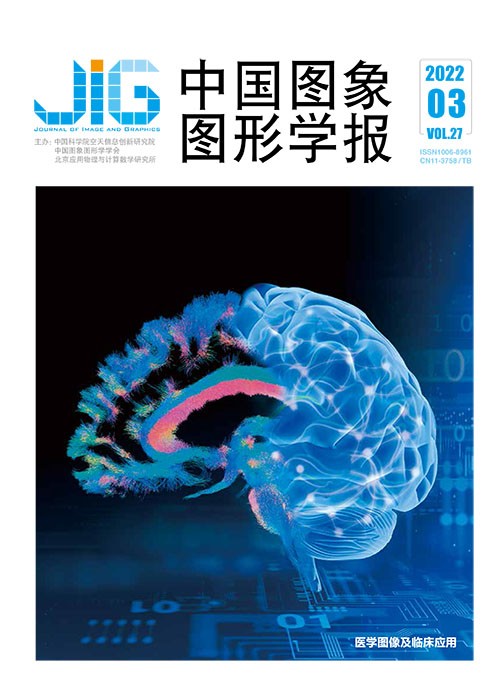
结构图注意力网络的新冠肺炎轻重症诊断
刘彦北1,2, 李赫南3, 张长青4, 肖志涛1, 张芳1, 隗英5, 高耀宗5, 石峰5, 单飞6, 沈定刚5,7(1.天津工业大学生命科学学院, 天津 300387;2.天津光电检测技术与系统重点实验室, 天津 300387;3.天津工业大学电子与信息工程学院, 天津 300387;4.天津大学智能与计算学部, 天津 300073;5.上海联影智能医疗科技有限公司, 上海 200232;6.复旦大学附属公共卫生临床中心, 上海 201508;7.上海科技大学生物医学工程学院, 上海 201210) 摘 要
目的 为辅助医生快速分辨新型冠状病毒肺炎(corona virus disease 2019,COVID-19)轻、重症患者,以便对症下药减轻医疗负担,提出一种基于结构图注意力网络的轻重症诊断算法。方法 基于胸部CT图像提取的特定特征以及肺段间的位置关系构建结构图,以肺部内不同肺段为节点,以提取特征为节点属性。采用图神经网络汇聚相邻节点特征,再利用池化层获取分别代表左肺叶和右肺叶特征的图表示。使用结构注意力机制计算左、右肺叶的感染情况对结果诊断的重要性,并依据重要性融合左、右肺叶图表示以得到最终图表示,最后执行分类任务。由于数据中存在明显的类别不平衡现象,采用Focal-Loss损失函数优化模型以减轻对分类结果的影响。结果 实验将所提算法分别与传统机器学习方法和流行的图神经网络算法做性能对比。在重症诊断的准确率上,本文算法相较于传统机器学习方法和图神经网络算法分别取得14.2%~42.0%和3.6%~4.8%的提升。在AUC (area under curve)指标上,本文算法相较于上述两种算法分别取得8.9%~18.7%和3.1%~3.6%的提升。除此之外,通过消融实验发现具有结构注意力机制的算法相较于未使用的算法在SPE (specificity)、SEN (sensitivity)和AUC 3个指标上分别取得了2.4%、1.4%和1.1%的提升;应用Focal-Loss损失函数的算法相较于未使用的算法提升了2.1%、1.1%和0.9%。结论 所提出的诊断模型综合了图神经网络以及结构注意力机制的优点,引入Focal-Loss损失函数,提升了困难样本的分类准确率,使诊断结果更加准确。
关键词
Diagnosis of COVID-19 by using structural attention graph neural network
Liu Yanbei1,2, Li Henan3, Zhang Changqing4, Xiao Zhitao1, Zhang Fang1, Wei Ying5, Gao Yaozong5, Shi Feng5, Shan Fei6, Shen Dinggang5,7(1.School of Life Sciences, Tiangong University, Tianjin 300387, China;2.Tianjin Key Laboratory of Optoelectronic Detection Technology and Systems, Tianjin 300387, China;3.School of Electronic and Information Engineering, Tiangong University, Tianjin 300387, China;4.College of Intelligence and Computer, Tianjin University, Tianjin 300073, China;5.Department of Research and Development, Shanghai United Imaging Intelligence Co., Ltd., Shanghai 200232, China;6.Department of Radiology, Shanghai Public Health Clinical Center, Fudan University, Shanghai 201508, China;7.School of Biomedical Engineering, ShanghaiTech University, Shanghai 201210, China) Abstract
Objective The primary routine clinical diagnosis of COVID-19(corona virus disease 2019) is usually conducted based on epidemiological history, clinical manifestations and various laboratory detection methods, including nucleic acid amplification test (NAAT), computed tomography (CT) scan and serological techniques. However, manual detection is costly, time-consuming and leads to the potential increase of the infection risk of clinicians. As a good alternative, artificial intelligence techniques on available data from laboratory tests play an important role in the confirmation of COVID-19 cases. Some studies have been designed for distinguishing between novel coronavirus pneumonia, community-acquired pneumonia and normal people by graph neural network. However, these studies leverage the relationships between features to build a topological structure graph (e.g., connecting the nodes with high similarity), while ignoring the inner relationships between different parts of the lung, and thus limiting the performance of their models. To address this issue, we propose a graph neural network with hierarchical information inherent to the physical structure of lungs for the improved diagnosis of COVID-19. Besides, an attention mechanism is introduced to capture the discriminative features of different severities of infection in the left and right lobes of different patients. Method Firstly, the topological structure is constructed based on the lungs' physical structure, and different lung segments are regarded as different nodes. Each node in the graph contains three kinds of handcrafted features, such as volume, density and mass feature, which reflect the infection in each lung segment and can be extracted from chest CT images using VB-Net. Secondly, based on graph neural network (GNN) and attention mechanism, we propose a novel structural attention graph neural network (SAGNN), which can perform the graph classification task. The SAGNN first aggregates the features in a given sample graph, and then uses the attention mechanism to effectively fuse the different features to obtain the final graph representation. This representation is then fed into a linear layer with softmax activation function that performs graph classification, so that the corresponding sample graph can be finally classified as a mild case or a severe one. To alleviate the effect of category imbalance on the classification results, we use the focal loss function. We optimize the proposed model via back propagation and learn the representations of graphs. Result To verify the effectiveness of the proposed method, we compared SAGNN with several classical machine learning methods and graph classification methods on a real COVID-19 dataset, which includes 358 severe cases and 1 329 mild cases, provided by Shanghai Public Health Clinical Center. The result of comparative experiments was measured using three evaluation metrics including the sensitivity (SEN), the specificity (SPE) and the area under the receiver operating characteristic(ROC) curve (AUC). In the experiments, our model had a good performance, indicating the effectiveness of our model. Based on comparison with the classical machine learning methods and the graph neural network methods, SAGNN outperformed by 14.2%~42.0% and 3.6%~4.8% in terms of SEN, respectively. In terms of AUC, the performance of SAGNN increased by 8.9%~18.7% and 3.1%~3.6%, respectively. In addition, through the ablation experiments of SAGNN, we found that the SAGNN with attention mechanism outperformed by 2.4%, 1.4% and 1.1% in SPE, SEN and AUC than the SAGNN not with attention mechanism, respectively. The SAGNN with focal loss function outperformed by 2.1%, 1.1% and 0.9% in SPE, SEN and AUC than the SAGNN with cross-entropy loss function, respectively. Conclusion In this work, we propose SAGNN, a new architecture for the diagnosis of severe and mild cases of COVID-19. Experimental results show the superior performance of SAGNN on classification task. Experimental results show that concatenating features of lung segments by their structure is effective. Moreover, we introduce an attention mechanism to distinguish the infection degree of right and left lungs. The focal loss is used to solve the issue of imbalanced group distribution, which further improves the overall network performance. We thus demonstrate the potential of SAGNN as clinical diagnosis support in this highly critical domain of medical intervention. We believe that our architecture provides a valuable case study for the early diagnosis of COVID-19, which is helpful for improvement in the field of computer-aided diagnosis and clinical practice.
Keywords
corona virus disease 2019(COVID-19) diagnosis graph neural network(GNN) structural attention mechanism topology diagram graph classification
|



 中国图象图形学报 │ 京ICP备05080539号-4 │ 本系统由
中国图象图形学报 │ 京ICP备05080539号-4 │ 本系统由